Automotive sensor types and development paths
1. Sensors are the eyes of the car, essential components for ADAS and autonomous driving systems.
In the process of advanced driver assistance systems (ADAS) and autonomous driving, the machine gradually takes over from human control, performing a series of tasks such as environmental perception, data analysis, and control execution.
The first step in this process is to use the car's "eyes"—sensors—to detect the surrounding environment. Common sensors used in automotive and assisted driving systems include microwave/millimeter-wave radar, ultrasonic sensors, cameras, and lidar.

2. Currently, the main types include millimeter-wave radar, camera, lidar, and infrared.
Each type of sensor has its own principle and function, and they each have their own advantages in different scenarios, making them difficult to replace.
Millimeter-wave radar is not affected by weather conditions and has a long detection range, making it cost-effective for vehicle ranging. However, it struggles with identifying pedestrians and traffic signs.
Cameras are low-cost and excel at object recognition, making them crucial for lane departure warnings and traffic sign identification. However, they rely on lighting, fail in extreme weather, and struggle with accurate distance measurement.
Lidar offers the highest detection accuracy and can create real-time 3D maps, making it a key component in autonomous vehicles like Google and Baidu. But it comes with high costs and performance issues in rain, snow, and fog.
Infrared technology is mature and commonly used in short-range collision avoidance systems, but it lacks the precision needed for long-distance applications, often used for reverse radar. Ultrasonic radar is low-cost and effective for short-range detection, such as parking assistance.
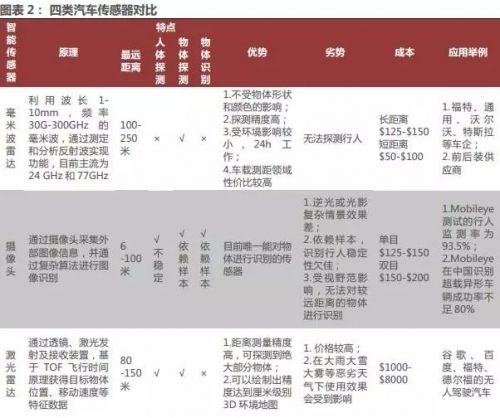
3. Countries have introduced policies to promote the adoption of ADAS systems.

The current penetration rate of ADAS systems is around 8-12% in some regions and 2-3% in others. With policy support and the influence of consumer electronics, the automotive sensor industry is expected to grow rapidly in the coming years. According to IHS Automotive, the global anti-collision sensor market reached $3.94 billion in 2014 and is projected to reach $9.9 billion by 2020.
4. OEMs and Tier 1 manufacturers remain the main players.
Automotive sensors are part of automotive electronics, requiring high standards of safety and stability. The early development and implementation have largely been driven by OEMs and Tier 1 suppliers. These companies have already established their own R&D capabilities or formed partnerships.
Most startups currently collaborate with OEMs, who then distribute the products through Tier 1 suppliers. Although there hasn't been much public attention in the past two years, the overall direction is correct, and future opportunities are likely.
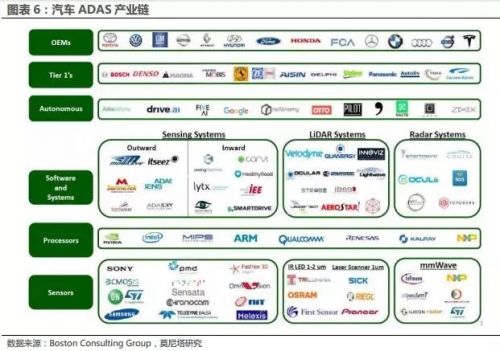
Millimeter-wave radar
Millimeter-wave radar consists mainly of three parts: the antenna (including the board and entire radar structure), the RF front-end chip, and the DSP signal processing unit. Among these, the MMIC (Monolithic Microwave Integrated Circuit) and the high-frequency PCB board for the radar antenna are critical components.
Currently, the front-end MMIC is controlled by foreign companies, especially the 77GHz MMIC, which is held by only a few international chip manufacturers like Infineon, ST, and Freescale. Domestic MMIC development is still in its early stages, mostly focused on 24GHz radar. Companies like Huayu Automobile, Hangzhou Zhibo, and Wuhu Senstek have made progress in this area.
Additionally, the high-frequency PCB boards for radar antennas are also dominated by foreign manufacturers. Schweizer holds 30% of the global market share, particularly in 77GHz radar. The laminated materials used in these PCBs are primarily supplied by Rogers and Isola. Domestic manufacturers lack technical expertise and still import based on design drawings. Hudian supplies PCBs to mainland China and Bosch, and they have collaborated with Schweizer on 24GHz and 77GHz high-frequency radar PCBs.
According to available information, the cost of long-range radar modules is typically between $60 and $120, while short-range ones are around $30 to $40. The costs are roughly divided equally among the antenna & board, RF front-end chip, and background DSP signal processing. However, business models also involve software licensing fees, which can be as high as tens of millions of dollars for some foreign companies.
The millimeter-wave radar market is highly concentrated and has been dominated by foreign auto parts giants based in Germany, the US, and Japan. Major companies include Bosch, Continental, Hella, Fujitsu Ten, Denso, Trina, Delphi, and Autoliv.
In 2015, the top three manufacturers—Bosch (22%), Zhejiang Mainland (22%), and Hella (13%)—accounted for more than half of the total market. Bosch’s long-range millimeter-wave radar is mainly used in ACC (Adaptive Cruise Control) systems. Its latest product, LRR4, can detect vehicles up to 250 meters away, making it the radar with the longest detection range. It is used by Audi and Volkswagen. Zhejiang Mainland offers a complete product line and holds a high market share in Stop&Go ACC. Hella leads in the 24GHz-ISM market.
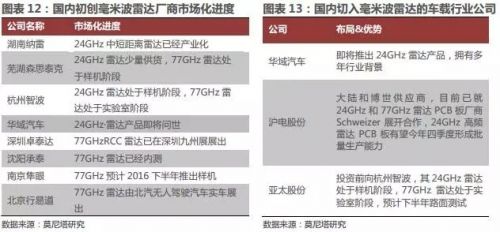
Currently, all millimeter-wave radar sensors installed in high-end cars in the Chinese market are imported, and there are no independent domestic radar products. According to our understanding, the first phase of domestic research and development has been basically completed. By the end of 2016, domestic independent radar products (24GHz) will be launched, mainly for blind spot detection (BSD), lane change assistance (LCA), and other functions. The second phase of domestic R&D will also focus on 24GHz products, aiming to reduce costs, with products expected to emerge by the end of next year.
Camera system industry chain
In-vehicle cameras are the main visual sensors for ADAS systems. After capturing images via the lens, the photosensitive component circuit and control components within the camera process the image into a digital signal that can be processed by a computer, enabling functions such as forward collision warning, lane offset alarm, and pedestrian detection.
The general principles of car cameras are as follows: 1) image processing, converting images into 2D data; 2) pattern recognition, identifying objects such as vehicles, pedestrians, lane lines, and traffic signs through image matching; 3) estimating the relative distance and speed of target objects using motion patterns or binocular positioning.
In terms of hardware, car cameras are mainly composed of CMOS lenses (including lens and light sensor chips), chips, and other materials (memory, SIM cards, casing). They are categorized into monocular, rear-view, stereo, and surround cameras, with monocular cameras being the most common.

In terms of software, Mobileye serves as an example, focusing on chip upgrades and platform improvements. The operating frequency increased from 122MHz to 332MHz, the access mode was upgraded to double the speed, and the image resolution was improved from 640×480 color pixels to 2048×2048 (input) and 4096×2048 (output), among other enhancements.
Except for a few vendors that integrate vertically, most focus on one or a few links in the supply chain.
From a market concentration perspective, optical lenses are mainly dominated by Taiwanese manufacturers, while mainland manufacturers have certain advantages in infrared cut-off filters. Image sensors are mainly produced by European, American, and Korean manufacturers, and module production is led by mainland China, South Korea, Taiwan, and Japanese manufacturers. Domestic manufacturers have grown rapidly. The optical lens industry is highly concentrated, with the top five manufacturers accounting for 60% of the market. Sunny Optical's shipments in 2015 accounted for 9.4% of the world market, making it the second-largest player globally.
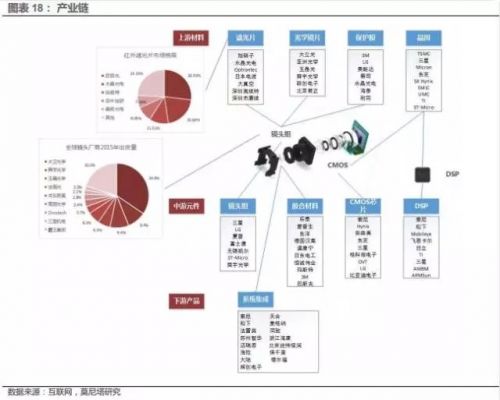
Monocular cameras will continue to dominate the market in the future. As 360-degree panoramic parking and surround vision systems develop, it is expected that more than six single-lens cameras will be used in a single vehicle, including one front view, one rear view, and four surround views. According to MRRSE reports, global car camera shipments grew at a compound annual rate of 11.3% from 2014 to 2016. It is estimated that by 2020, global car camera sales will reach 83 million units.
In the next five years, the productization and miniaturization of binocular cameras may gradually break through, such as the binocular and multi-purpose solutions developed by Tras.
Graphics processing chips and algorithm advancements are key areas. Algorithm development is increasingly based on deep learning, while chip development focuses on upgrading products like Mobileye's EyeQ series, with anticipation of the EyeQ5 release.
Future market outlook
1. Mainstream car companies began deploying part of their second-stage automation in 2014.
Some major brands started deploying second-stage autopilot features in 2014. Most automakers have already implemented autopilots, and as technology matures, the level of autonomy continues to increase.
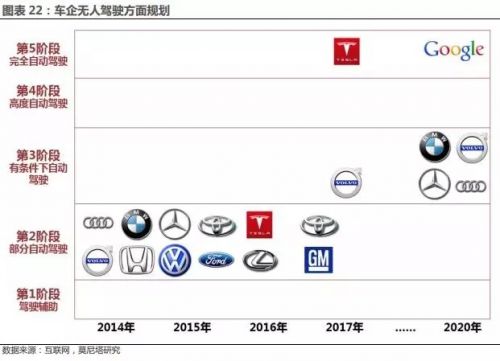
2. It is estimated that the automotive sensor market will reach $9.9 billion by 2020.
In 2014, the global ADAS new car penetration rate was approximately 15%, mainly in the U.S. and German premium markets, and about 3% in China. With stricter regulations and growing demand for ADAS, foreign manufacturers have mandated the installation of many ADAS features by 2018. It is expected that basic models will be equipped with ADAS functions by 2020.
According to Isuppli's forecast, by 2016, the global and Chinese ADAS markets will be approximately $6 billion and $1.5 billion, respectively. By 2020, the global and Chinese ADAS markets are expected to reach $30 billion and $3 billion, respectively.
Our company specializes in the production and sales of all kinds of terminals, copper terminals, nose wire ears, cold pressed terminals, copper joints, but also according to customer requirements for customization and production, our raw materials are produced and sold by ourselves, we have their own raw materials processing plant, high purity T2 copper, quality and quantity, come to me to order it!
LYF Copper Lube Terminals,Ring insulated terminals
Taixing Longyi Terminals Co.,Ltd. , https://www.txlyterminals.com